High-Fidelity 3D Stray Magnetic Field Mapping of Smartphones to Address Safety Considerations with Active Implantable Electronic Medical Devices
Abstract
1. Introduction
2. Materials and Methods
2.1. Mapping Magnetic Flux Density
2.2. Data Analysis
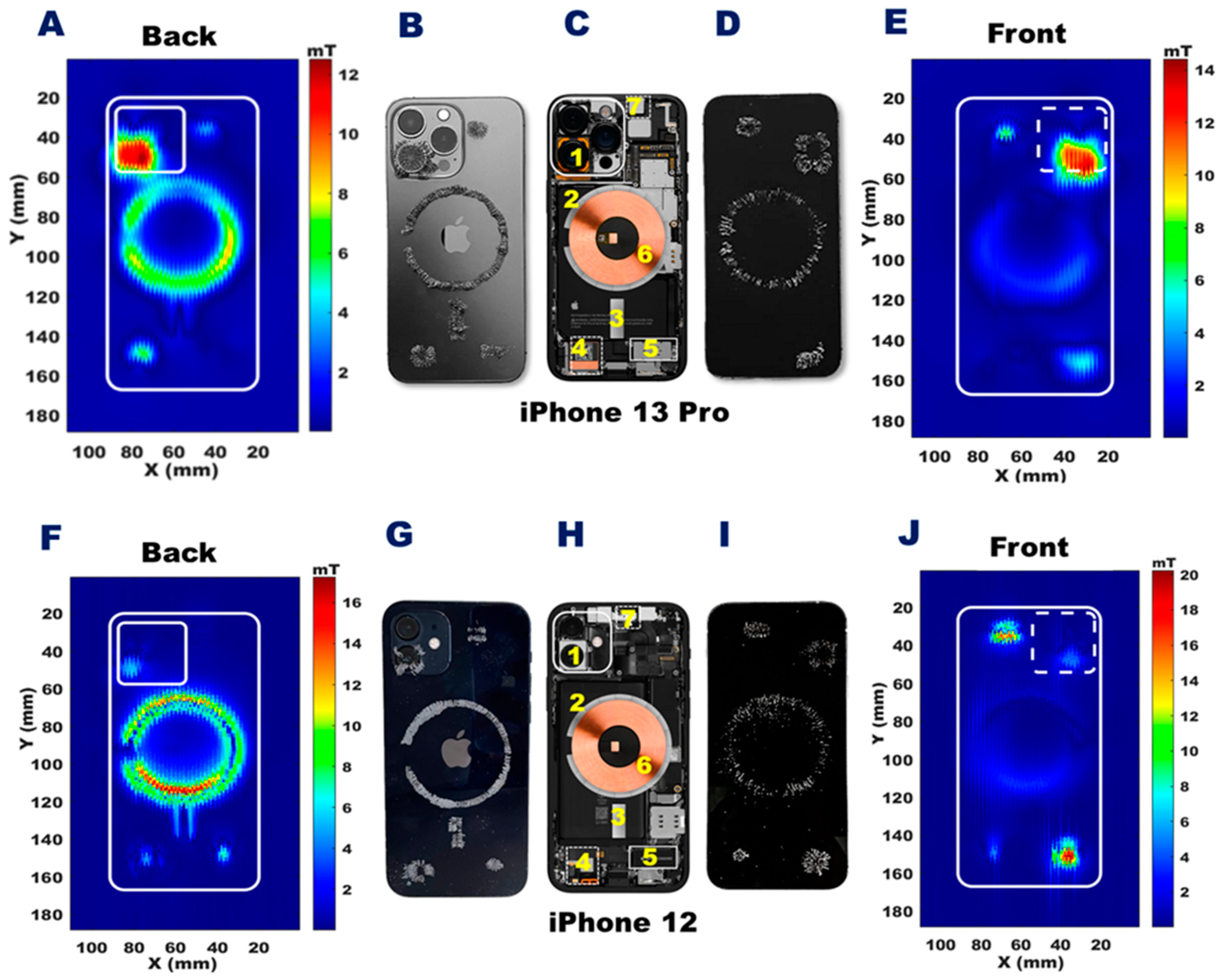
3. Results
3.1. Large Field-of-View B-Field Mapping
3.2. Small Field-of-View B-Field Mapping of Specific Components
4. Discussion and Conclusions
Supplementary Materials
Author Contributions
Funding
Institutional Review Board Statement
Informed Consent Statement
Data Availability Statement
Acknowledgments
Conflicts of Interest
References
- Intelligence, K.S. Active Implantable Medical Devices (AIMD) Market Size, Share, Opportunities, And Trends By Product (Ventricular Assist Devices, Neurostimulators, Implantable Cardiac Pacemakers, Cochlear Implants, Others), By End-Users (Hospitals And Clinics, Ambulatory Surgical Centers), and by Geography—Forecasts From 2021 To 2026. Available online: https://www.knowledge-sourcing.com/report/active-implantable-medical-devices-aimd-market (accessed on 2 September 2022).
- Research, N.; National Institute of Cardiovascular Outcomes Research. National Audit of Cardiac Rhythm Management Devices: Aprill 2015–March 2016. Available online: https://www.nicor.org.uk/wp-content/uploads/2019/02/crm-devices-national-audit-report-2015-16_v2.pdf (accessed on 2 September 2022).
- Greenberg, J.C.; Altawil, M.R.; Singh, G. Letter to the Editor-Lifesaving therapy inhibition by phones containing magnets. Heart Rhythm 2021, 18, 1040–1041. [Google Scholar] [CrossRef]
- Held, E.P.; Shehata, M.; Swerdlow, C.D.; Sandhu, R.K. To the Editor-Interference of smartphones containing magnets and cardiac implantable electronic devices-Is this common? Heart Rhythm 2021, 18, 1042–1043. [Google Scholar] [CrossRef]
- Patterson, Z.; Straw, S.; Drozd, M.; Paton, M.F.; Cole, C.; Witte, K.K.; Gierula, J. To the Editor-New phones, old problem? Interference with cardiovascular implantable electronic devices by phones containing magnets. Heart Rhythm 2021, 18, 1041. [Google Scholar] [CrossRef]
- Nadeem, F.; Nunez Garcia, A.; Thach Tran, C.; Wu, M. Magnetic Interference on Cardiac Implantable Electronic Devices From Apple iPhone MagSafe Technology. J. Am. Heart Assoc. 2021, 10, e020818. [Google Scholar] [CrossRef]
- Apakuppakul, S.; Methachittiphan, N.; Apiyasawat, S. Effect of ElectroMagnetic interference from SmartPHone on cardiac ImplaNtable electronic device (EMI-PHONE study). J. Arrhythm. 2022, 38, 778–782. [Google Scholar] [CrossRef]
- Censi, F.; Mattei, E.; Onder, G.; Calcagnini, G. iPhone 12 MagSafe technology and cardiac implantable devices: Assessment of the actual risk. Pacing Clin. Electrophysiol. 2022, 45, 410–417. [Google Scholar] [CrossRef]
- Chatterjee, D. Interaction of iPhone 12 with cardiac implantable electronic devices: Is it of any clinical concern? Europace 2022, 24, 179–180. [Google Scholar] [CrossRef]
- Nadeem, F.; Tran, C.T.; Torbey, E.; Philbin, D.; Morales, C.; Wu, M. Interference by Modern Smartphones and Accessories with Cardiac Pacemakers and Defibrillators. Curr. Cardiol. Rep. 2022, 24, 347–353. [Google Scholar] [CrossRef]
- Xu, K.; Sengupta, J.; Casey, S.; Peltier, J.; Stahl, W.; Peterson, N.; Settimi, D.; Taylor, A.; Kippola, J.; Steele, E.; et al. Magnetic field interactions between current consumer electronics and cardiac implantable electronic devices. J. Interv. Card Electrophysiol. 2022, 65, 133–139. [Google Scholar] [CrossRef]
- Ellis, C.R.; King, N.E. Cardiac Implantable Electronic Devices and Consumer Electronic Devices: The Proof Is in the Front Pocket. J. Innov. Card Rhythm. Manag. 2022, 13, 5073–5076. [Google Scholar] [CrossRef]
- Hayes, D.L.; Wang, P.J.; Reynolds, D.W.; Estes, M., 3rd; Griffith, J.L.; Steffens, R.A.; Carlo, G.L.; Findlay, G.K.; Johnson, C.M. Interference with cardiac pacemakers by cellular telephones. N. Engl. J. Med. 1997, 336, 1473–1479. [Google Scholar] [CrossRef]
- Hekmat, K.; Salemink, B.; Lauterbach, G.; Schwinger, R.H.; Südkamp, M.; Weber, H.J.; Mehlhorn, U. Interference by cellular phones with permanent implanted pacemakers: An update. Europace 2004, 6, 363–369. [Google Scholar] [CrossRef]
- Patel, H.; Whitler, C.; Foster, N.; Bradley, C.; Shah, D.; Machado, C. Implantable Cardioverter-defibrillator Magnetic Interference by the iPhone 12: Is It Clinically Significant? J. Innov. Card Rhythm. Manag. 2022, 13, 5070–5072. [Google Scholar] [CrossRef]
- Haugaa, K.H.; Potpara, T.S.; Boveda, S.; Deharo, J.C.; Chen, J.; Dobreanu, D.; Fumagalli, S.; Lenarczyk, R.; Hernandez Madrid, A.; Larsen, T.B.; et al. Patients’ knowledge and attitudes regarding living with implantable electronic devices: Results of a multicentre, multinational patient survey conducted by the European Heart Rhythm Association. Europace 2018, 20, 386–391. [Google Scholar] [CrossRef]
- Lacour, P.; Parwani, A.S.; Schuessler, F.; Hohendanner, F.; Heinzel, F.R.; Trippel, T.D.; Boldt, L.H.; Pieske, B.; Blaschke, F. Are Contemporary Smartwatches and Mobile Phones Safe for Patients With Cardiovascular Implantable Electronic Devices? JACC Clin. Electrophysiol. 2020, 6, 1158–1166. [Google Scholar] [CrossRef]
- Lee, S.; Fu, K.; Kohno, T.; Ransford, B.; Maisel, W.H. Clinically significant magnetic interference of implanted cardiac devices by portable headphones. Heart Rhythm 2009, 6, 1432–1436. [Google Scholar] [CrossRef]
- Tiikkaja, M.; Aro, A.; Alanko, T.; Lindholm, H.; Hietanen, M. Inappropriate implantable cardioverter-defibrillator magnet-mode switch induced by a laptop computer. Pacing Clin. Electrophysiol. 2012, 35, e177–e178. [Google Scholar] [CrossRef]
- Zaphiratos, V.; Donati, F.; Drolet, P.; Bianchi, A.; Benzaquen, B.; Lapointe, J.; Fortier, L.P. Magnetic interference of cardiac pacemakers from a surgical magnetic drape. Anesth. Analg. 2013, 116, 555–559. [Google Scholar] [CrossRef]
- Rahimpour, S.; Kiyani, M.; Hodges, S.E.; Turner, D.A. Deep brain stimulation and electromagnetic interference. Clin. Neurol. Neurosurg. 2021, 203, 106577. [Google Scholar] [CrossRef]
- ISO, I.S. ISO 14117:2019 Active Implantable Medical Devices-Electromagnetic Compatibility-EMC Test Protocols for Implantable Cardiac Pacemakers, Implantable Cardioverter Defibrillators and Cardiac Resynchronization Devices. Available online: https://www.iso.org/standard/73915.html (accessed on 2 September 2022).
- ISO, I.S. ISO 14708-6:2019 Implants for Surgery-Active Implantable Medical Devices-Part 6: Particular Requirements for Active Implantable Medical Devices Intended to Treat Tachyarrhythmia. Available online: https://www.iso.org/standard/67700.html (accessed on 2 September 2022).
- Inc., A. Apple Support. About Potential Magnetic Interference with Medical Devices with iPhone 12 Series and iPhone 13 series and MagSafe Accessories. Available online: https://support.apple.com/en-us/HT211900 (accessed on 2 September 2022).
- Seidman, S.J.; Guag, J.; Beard, B.; Arp, Z. Static magnetic field measurements of smart phones and watches and applicability to triggering magnet modes in implantable pacemakers and implantable cardioverter-defibrillators. Heart Rhythm 2021, 18, 1741–1744. [Google Scholar] [CrossRef]
- Fery, C.; Desombre, A.; Quirin, T.; Badertscher, P.; Sticherling, C.; Knecht, S.; Pascal, J. Magnetic Field Measurements of Portable Electronic Devices: The Risk Inside Pockets for Patients With Cardiovascular Implantable Devices. Circ. Arrhythm. Electrophysiol. 2022, 15, e010646. [Google Scholar] [CrossRef] [PubMed]
- Quirin, T.; Vergne, C.; Féry, C.; Badertscher, P.; Nicolas, H.; Mannhart, D.; Osswald, S.; Kuhne, M.; Sticherling, C.; Madec, M.; et al. A magnetic camera to assess the risk of magnetic interaction between portable electronics and cardiac implantable electronic devices. In Proceedings of the 2022 IEEE International Symposium on Medical Measurements and Applications (MeMeA), Messina, Italy, 22–24 June 2022; pp. 1–6. [Google Scholar]
- Lacour, P.; Dang, P.L.; Heinzel, F.R.; Parwani, A.S.; Bähr, F.; Kucher, A.; Hohendanner, F.; Niendorf, T.; Rahimi, F.; Saha, N.; et al. Magnetic field-induced interactions between phones containing magnets and cardiovascular implantable electronic devices: Flip it to be safe? Heart Rhythm 2022, 19, 372–380. [Google Scholar] [CrossRef]
- Han, H.; Moritz, R.; Oberacker, E.; Waiczies, H.; Niendorf, T.; Winter, L. Open Source 3D Multipurpose Measurement System with Submillimetre Fidelity and First Application in Magnetic Resonance. Sci. Rep. 2017, 7, 13452. [Google Scholar] [CrossRef] [PubMed]
- Inc., A. Accessory Design Guidelines for Apple devices. Apple Inc Website. Updated 16 October 2021. Available online: https://developer.apple.com/accessories/Accessory-Design-Guidelines.pdf (accessed on 2 September 2022).
- Poljak, D.; Cvetković, M. Incident electromagnetic field dosimetry. In Human Interaction with Electromagnetic Fields: Computational Models in Dosimetry, 1st ed.; Academic Press: New York, NY, USA, 2019; pp. 53–89. [Google Scholar]
- Community Coordinated Modelling Center, l.a.N.G.S.F.C.G. Properties of Magnetic Dipoles. Available online: https://ccmc.gsfc.nasa.gov/static/files/Dipole.pdf (accessed on 2 September 2022).
- dbrand. Teardown Skins iPhone 12 and iPhone 13 Pro. Available online: https://dbrand.com/iphone-skins (accessed on 2 September 2022).
- IFixit. IFixit.Teardown of the iPhone 12 and 12Pro. Available online: https://de.ifixit.com/Teardown/iPhone+12+und+12+Pro+Teardown/137669 (accessed on 2 September 2022).
- IFixit. IFixit.Teardown of the iPhone 13Pro. Available online: https://de.ifixit.com/Teardown/iPhone+13+Pro+Teardown/144928 (accessed on 2 September 2022).
- Boccard, S.G.J.; Prangnell, S.J.; Pycroft, L.; Cheeran, B.; Moir, L.; Pereira, E.A.C.; Fitzgerald, J.J.; Green, A.L.; Aziz, T.Z. Long-Term Results of Deep Brain Stimulation of the Anterior Cingulate Cortex for Neuropathic Pain. World Neurosurg. 2017, 106, 625–637. [Google Scholar] [CrossRef] [PubMed]
- Deuschl, G.; Schade-Brittinger, C.; Krack, P.; Volkmann, J.; Schafer, H.; Botzel, K.; Daniels, C.; Deutschlander, A.; Dillmann, U.; Eisner, W.; et al. A randomized trial of deep-brain stimulation for Parkinson’s disease. N. Engl. J. Med. 2006, 355, 896–908. [Google Scholar] [CrossRef] [PubMed]
- Nutt, J.G.; Anderson, V.C.; Peacock, J.H.; Hammerstad, J.P.; Burchiel, K.J. DBS and diathermy interaction induces severe CNS damage. Neurology 2001, 56, 1384–1386. [Google Scholar] [CrossRef] [PubMed]
- Childrens, N. Cochlear Implant (CI) Magnet. Available online: https://www.nationwidechildrens.org/family-resources-education/health-wellness-and-safety-resources/helping-hands/cochlear-implant-ci-magnet (accessed on 2 September 2022).
- Todt, I.; Guerkov, R.; Gehl, H.B.; Sudhoff, H. Comparison of Cochlear Implant Magnets and Their MRI Artifact Size. Biomed. Res. Int. 2020, 2020, 5086291. [Google Scholar] [CrossRef] [PubMed]
- Plawecki, A.; Tripathi, N.; Tovar Torres, M.; Yaremchuk, K. Interference With Implanted Upper Airway Stimulation Device by Phones With Magnet Technology. Laryngoscope 2022, 132, 2513–2515. [Google Scholar] [CrossRef]
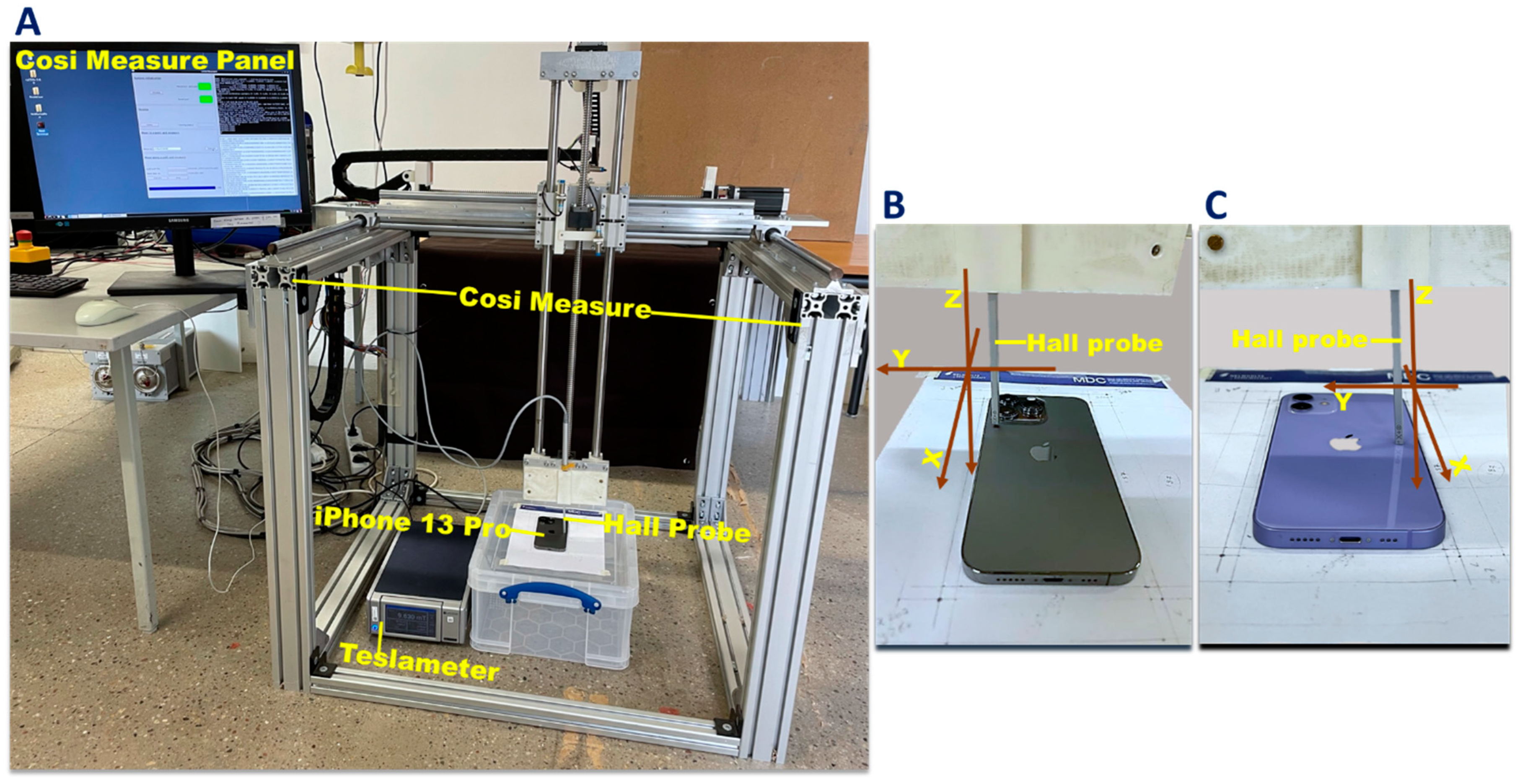
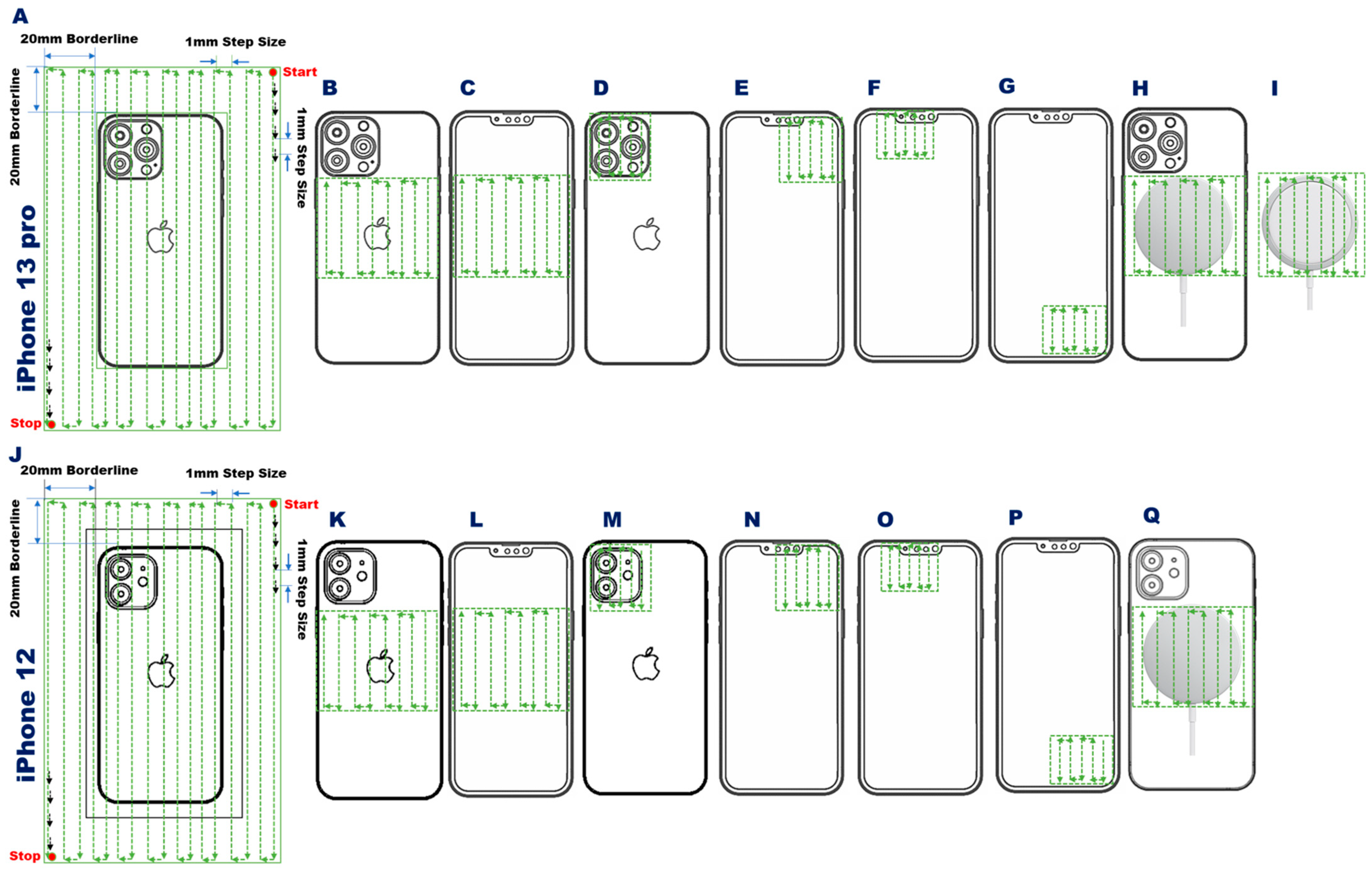

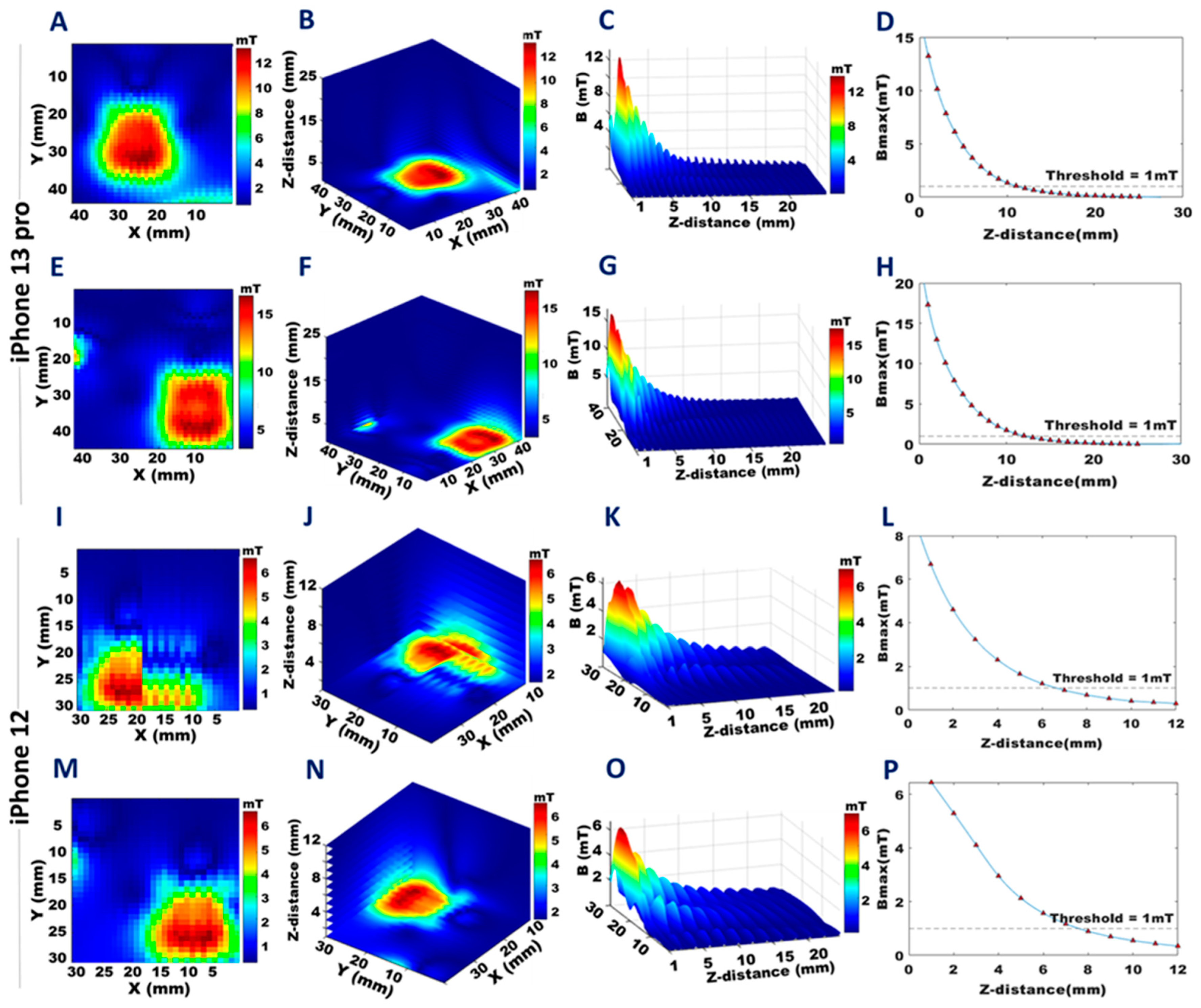
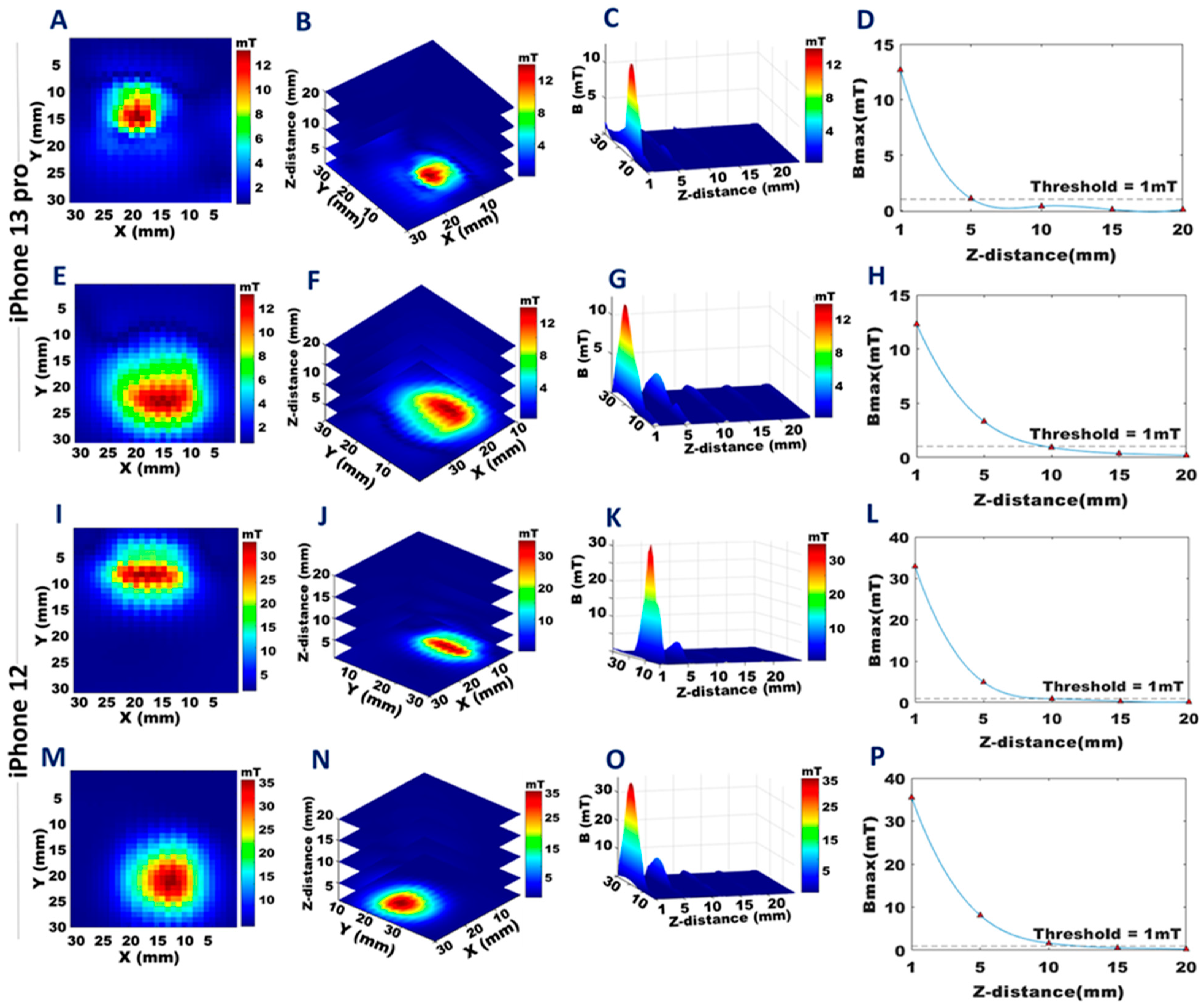

Disclaimer/Publisher’s Note: The statements, opinions and data contained in all publications are solely those of the individual author(s) and contributor(s) and not of MDPI and/or the editor(s). MDPI and/or the editor(s) disclaim responsibility for any injury to people or property resulting from any ideas, methods, instructions or products referred to in the content. |
© 2023 by the authors. Licensee MDPI, Basel, Switzerland. This article is an open access article distributed under the terms and conditions of the Creative Commons Attribution (CC BY) license (https://creativecommons.org/licenses/by/4.0/).
Share and Cite
Saha, N.; Millward, J.M.; Herrmann, C.J.J.; Rahimi, F.; Han, H.; Lacour, P.; Blaschke, F.; Niendorf, T. High-Fidelity 3D Stray Magnetic Field Mapping of Smartphones to Address Safety Considerations with Active Implantable Electronic Medical Devices. Sensors 2023, 23, 1209. https://doi.org/10.3390/s23031209
Saha N, Millward JM, Herrmann CJJ, Rahimi F, Han H, Lacour P, Blaschke F, Niendorf T. High-Fidelity 3D Stray Magnetic Field Mapping of Smartphones to Address Safety Considerations with Active Implantable Electronic Medical Devices. Sensors. 2023; 23(3):1209. https://doi.org/10.3390/s23031209
Chicago/Turabian StyleSaha, Nandita, Jason M. Millward, Carl J. J. Herrmann, Faezeh Rahimi, Haopeng Han, Philipp Lacour, Florian Blaschke, and Thoralf Niendorf. 2023. "High-Fidelity 3D Stray Magnetic Field Mapping of Smartphones to Address Safety Considerations with Active Implantable Electronic Medical Devices" Sensors 23, no. 3: 1209. https://doi.org/10.3390/s23031209
APA StyleSaha, N., Millward, J. M., Herrmann, C. J. J., Rahimi, F., Han, H., Lacour, P., Blaschke, F., & Niendorf, T. (2023). High-Fidelity 3D Stray Magnetic Field Mapping of Smartphones to Address Safety Considerations with Active Implantable Electronic Medical Devices. Sensors, 23(3), 1209. https://doi.org/10.3390/s23031209








